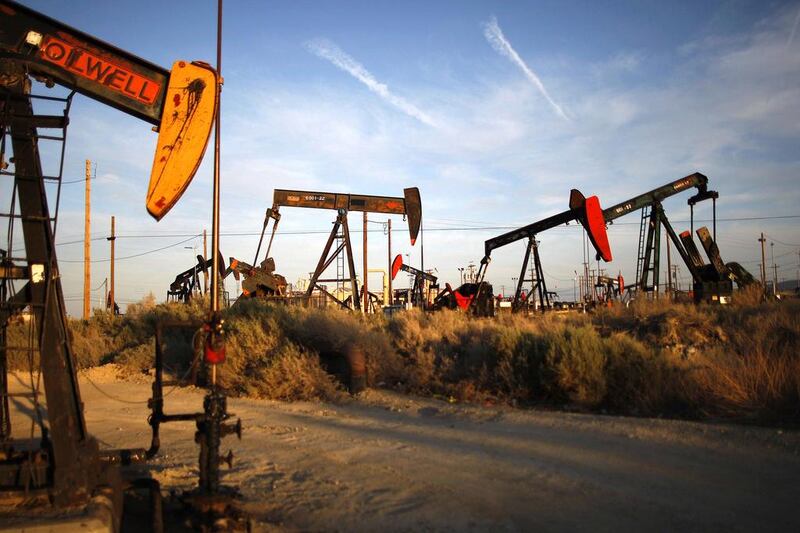Oil prices closed sharply higher on Friday but still posted a third consecutive week of losses on signs of weakening global crude demand.
Brent, the benchmark for two thirds of the world’s oil, surged 3.86 per cent, or $2.80, to settle at $75.30 a barrel. West Texas Intermediate, the gauge that tracks US crude, jumped up 4.05 per cent, or $2.78, to close at $71.34 a barrel.
For the week, Brent lost 5.3 per cent, while WTI, which saw its price drop to lows last seen in late 2021 after four straight sessions of losses, slipped 7.1 per cent.
“Crude prices remain heavy on weakening demand from Asia and [amid] US banking turmoil,” said Edward Moya, senior market analyst at Oanda.
“This banking crisis might make the oil market start pricing a much worse recession for the US, which is bad news for the crude demand outlook.”
Oil futures fell for two straight weeks as a crisis at regional banks in the US led to the collapse of First Republic Bank, the second-largest banking failure in the country's history.
The US has had three other failures this year — Silicon Valley Bank, Signature Bank and cryptocurrency-focused lender Silvergate Capital.
The US Federal Reserve on Wednesday raised interest rates by 25 basis points, its tenth consecutive increase, and indicated a possible pause in future.
The latest action brings the Fed's interest rates to the target range of between 5 per cent and 5.25 per cent.
“The outlook for the economy is getting uglier by the day and that is making it easier for energy traders to jump on the momentum selling that is hitting … crude,” said Mr Moya.
Traders will be closely following the US employment data for April, which will be released later today.
Initial jobless claims in the US — an indicator for layoffs — were at 242,000 in the week ending on April 29, up from 229,000 the previous week, according to the Labour Department.
“This was the largest uptick for the measure in the past six weeks, in a further signal that the US labour market is starting to slow after a bout of remarkable resilience through the past year,” said Daniel Richards, Mena Economist at Emirates NBD.
Meanwhile, manufacturing activity in China, the world’s second largest economy and top crude importer, contracted in April amid lower domestic demand.
The Caixin manufacturing purchasing managers' index, which gives a snapshot of the country’s manufacturing sector, slipped to 49.5 in April from 50.0 in March. A reading below 50 suggests contraction in the sector.
On the supply side, Iraq, Opec’s second-largest producer after Saudi Arabia, has reportedly set a date for the resumption of oil exports from the Kurdistan region. About 450,000 barrels of crude pass through the export channel.
“The central government has reached the final stages of implementing the agreement with Erbil on the resumption of oil exports from the Kurdistan region,” Iraq’s oil minister Hayan Abdul Ghani was quoted as saying by the Iraqi News Agency on Thursday.
“The oil marketing company that took care of the process of receiving and exporting oil from the region is now in the process of signing contracts with companies that buy oil,” Mr Ghani said.
“In the coming days, the resumption of oil exports will be announced.”
In March, an international arbitration ruling declared that Kurdish oil exports were illegal, leading to the shutdown of oil supply to the main export pipeline through the Turkish port of Ceyhan. The move halted about 0.5 per cent of global crude supply.
Baghdad and Erbil reached an agreement last month to resume crude flows, but exports have remained suspended due to unresolved issues.
Despite the recent market volatility, UBS said it is retaining a positive outlook and expects the oil market to tighten as Opec+ members implement their production cuts and oil demand rises over the coming months.
“Flight activity has rebounded strongly this year, with activity around 2019 levels. Generally, we see oil demand holding up and look for even higher demand over the coming months,” UBS strategist Giovanni Staunovo said in a research note on Thursday.
“The lower potential Opec+ crude production and exports should help the oil market tighten, supporting our view that oil inventories will begin to decline and support prices.”
Brent crossed $85 a barrel last month after Opec+ producers announced voluntary output cuts of 1.16 million barrels per day to ensure oil market stability.
"The surprise cut hasn't proven to be much of a deterrent for sellers, although it may have contributed to the price rebounding around the March lows," said Craig Erlam, senior market analyst at Oanda.
"It would appear volatility is here to stay and traders may be wary about another surprise intervention, although the next meeting is now a month away."






